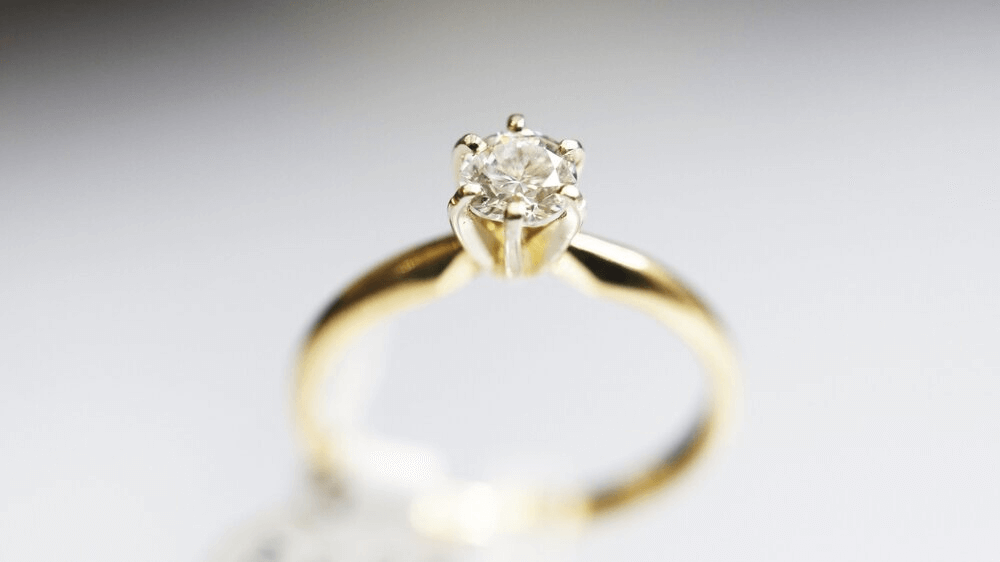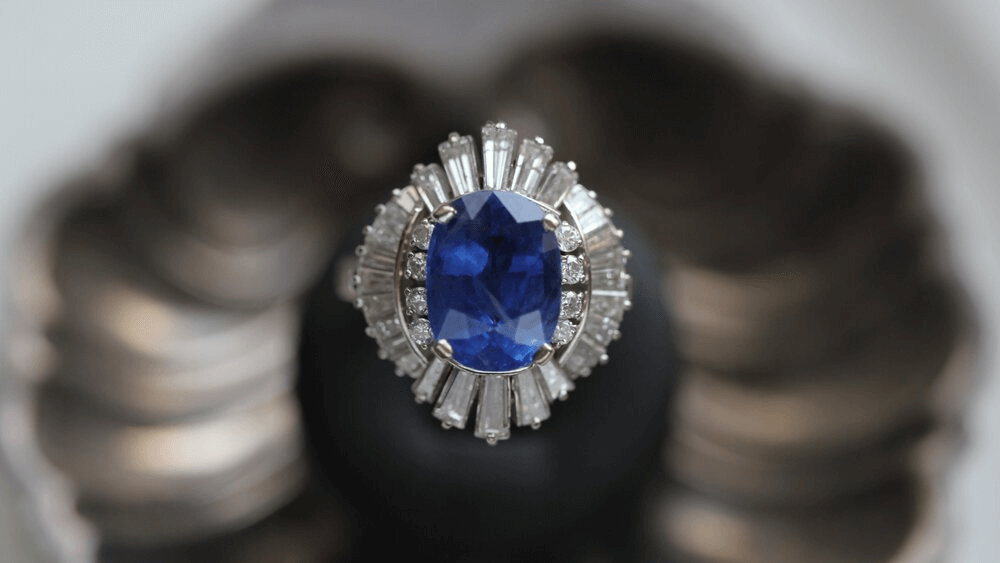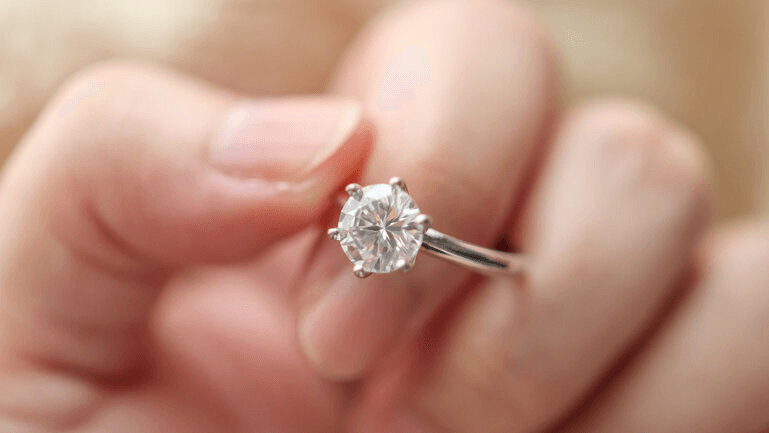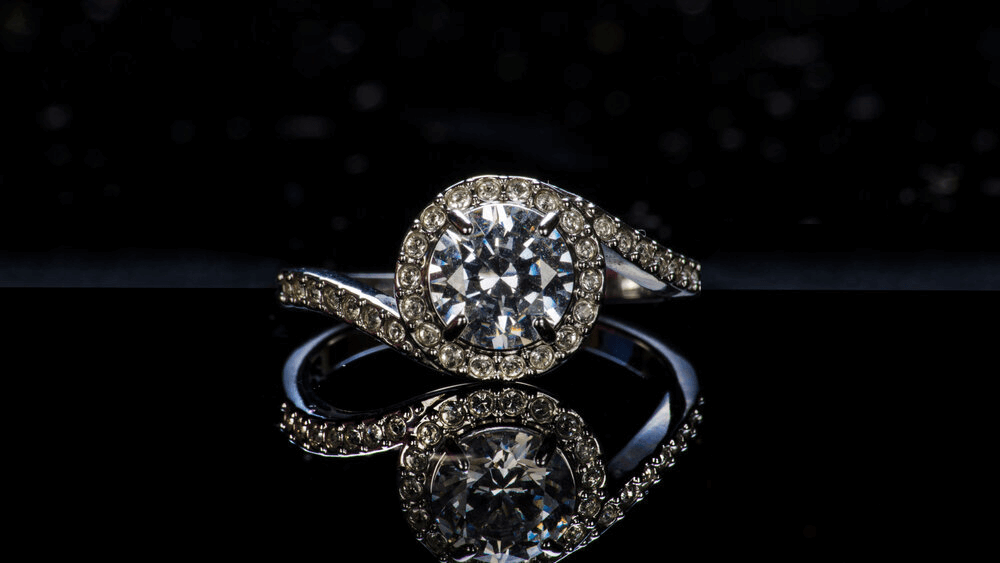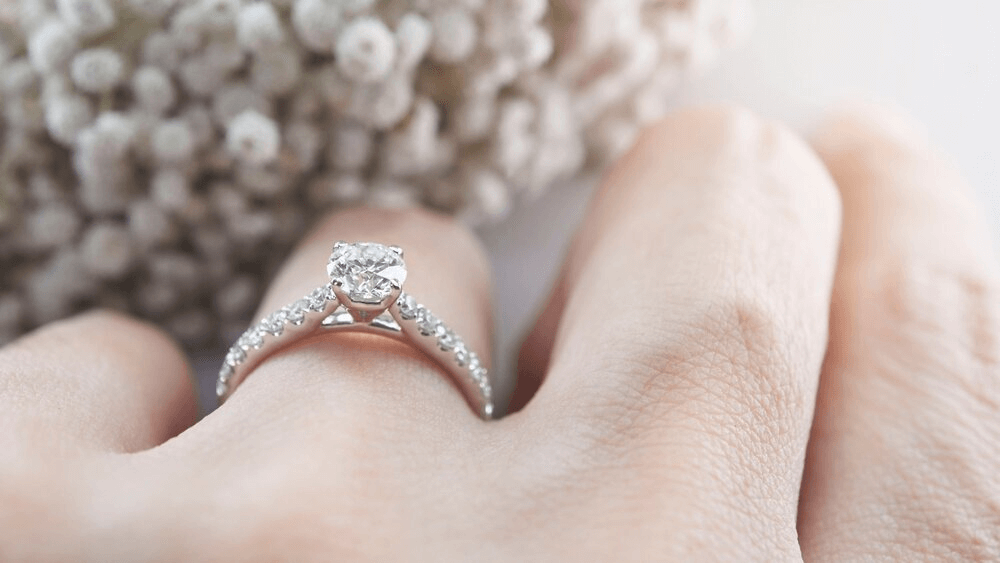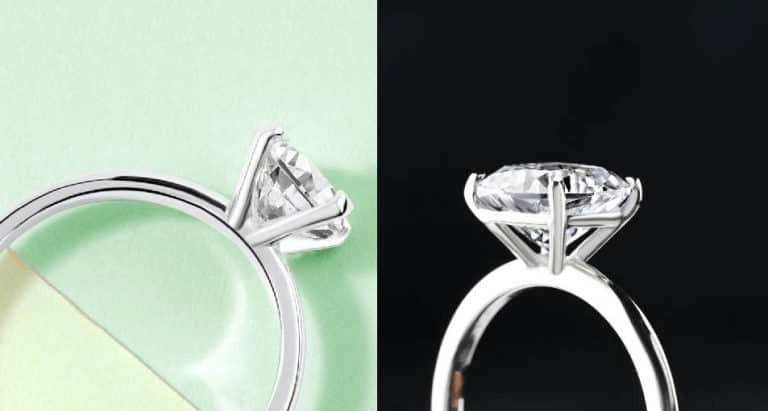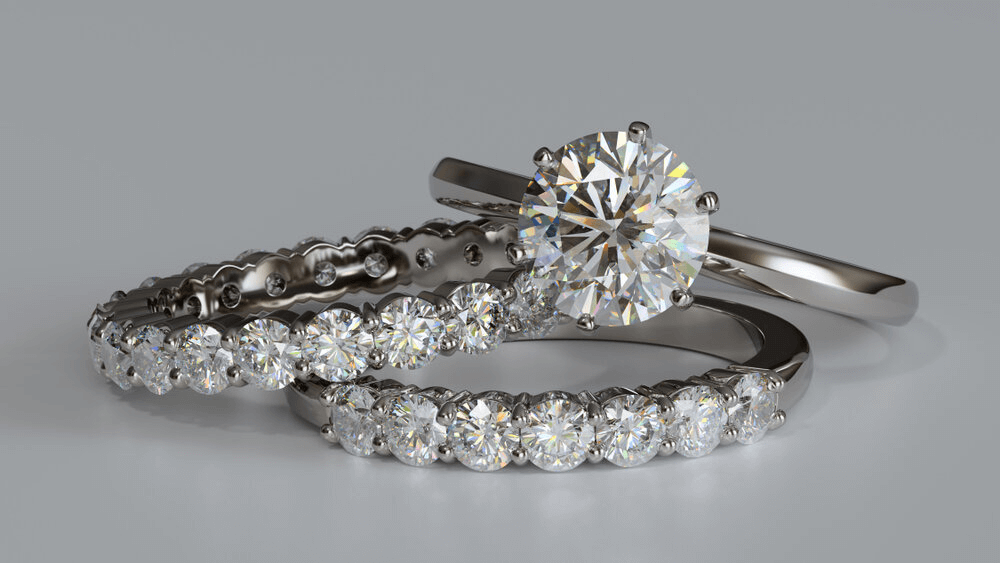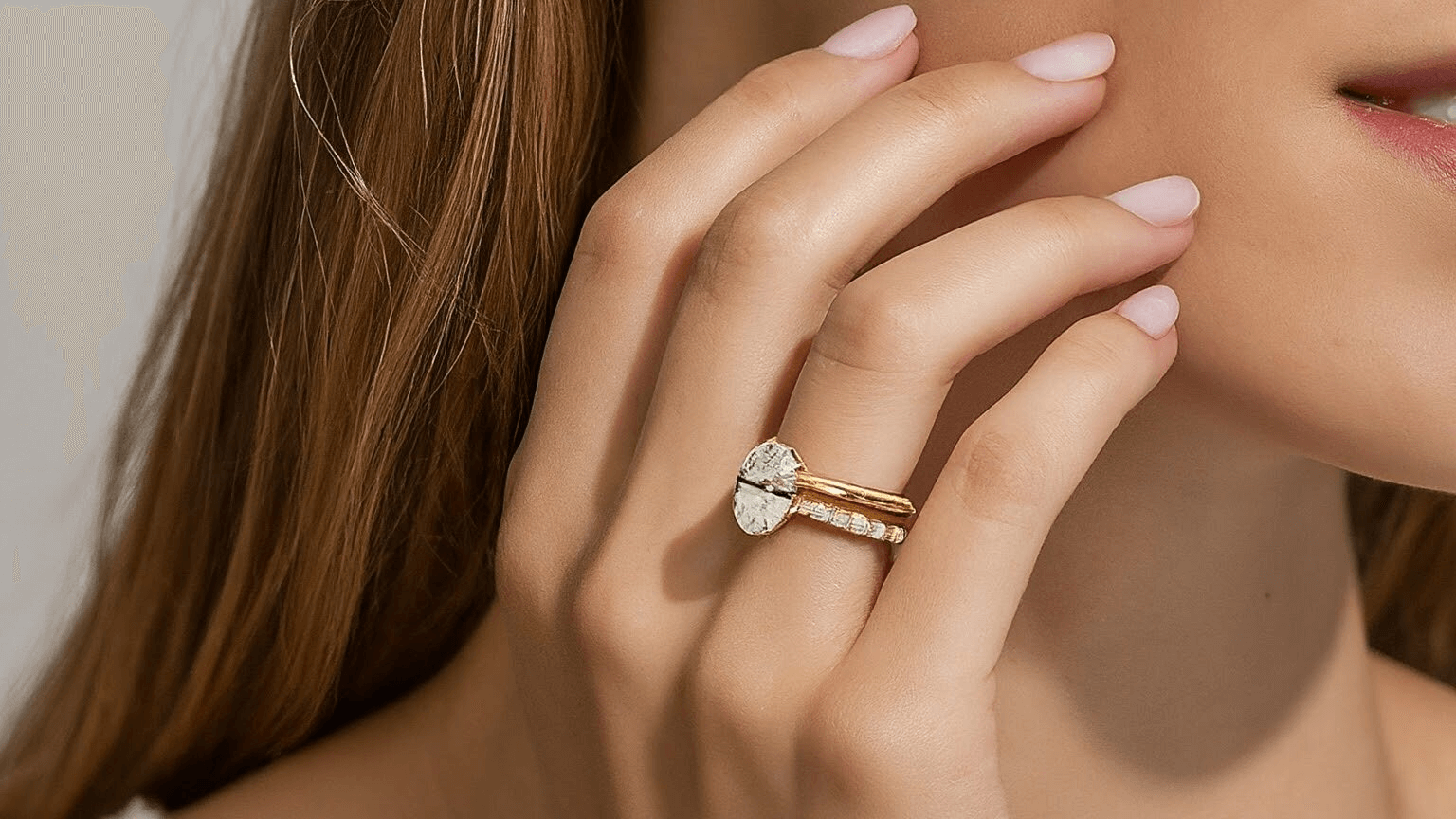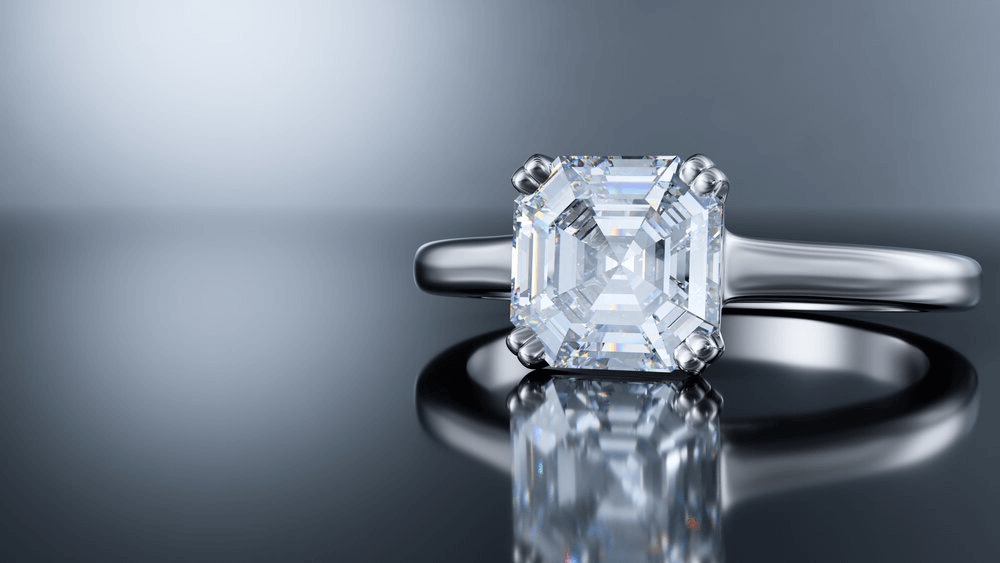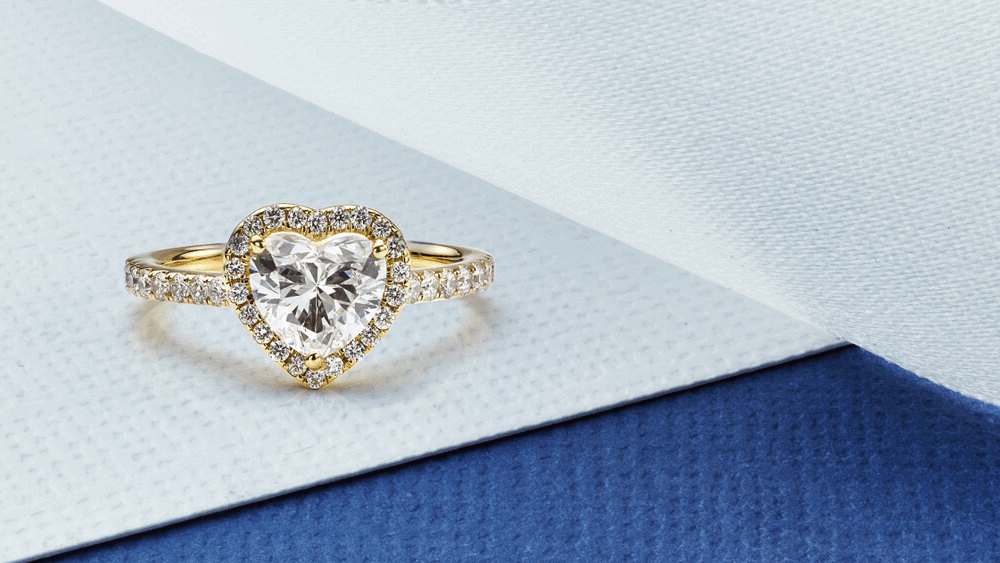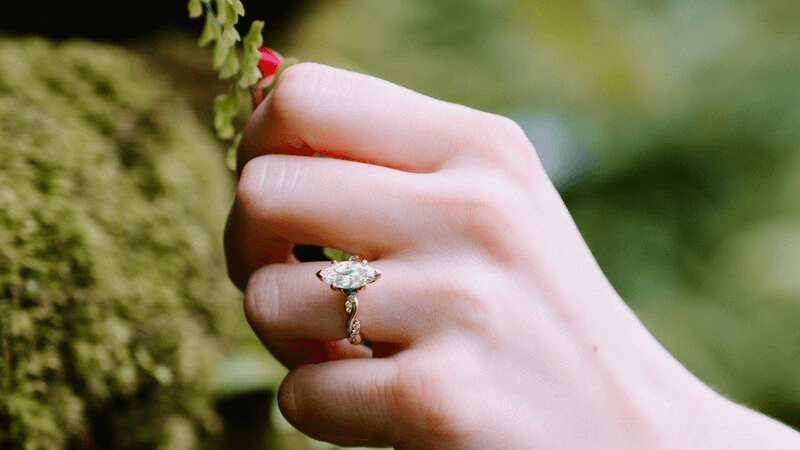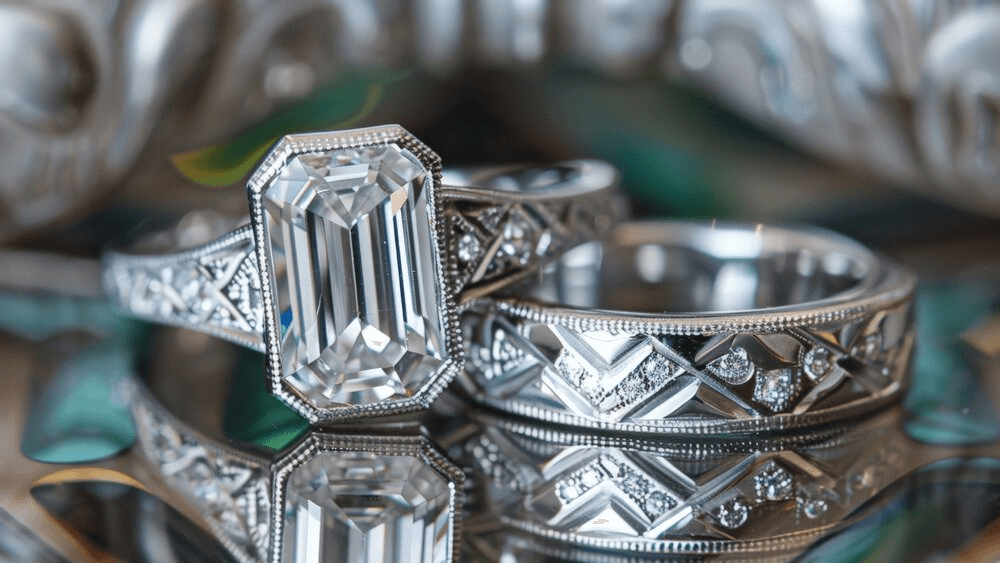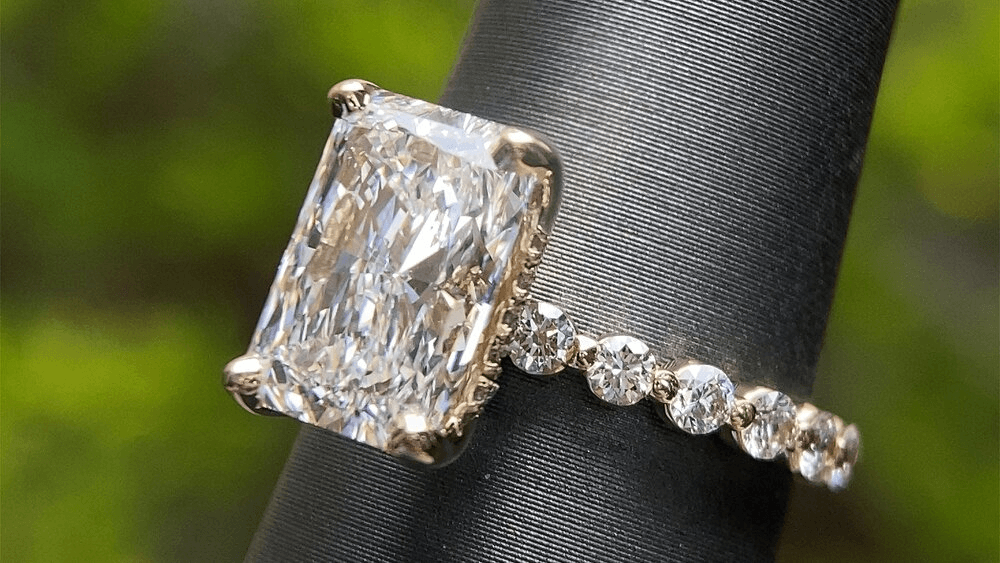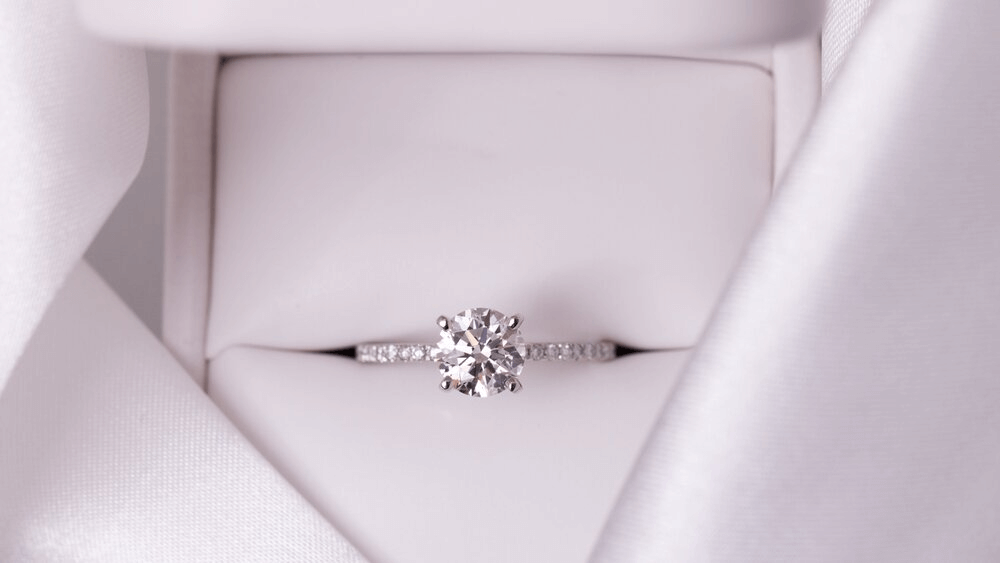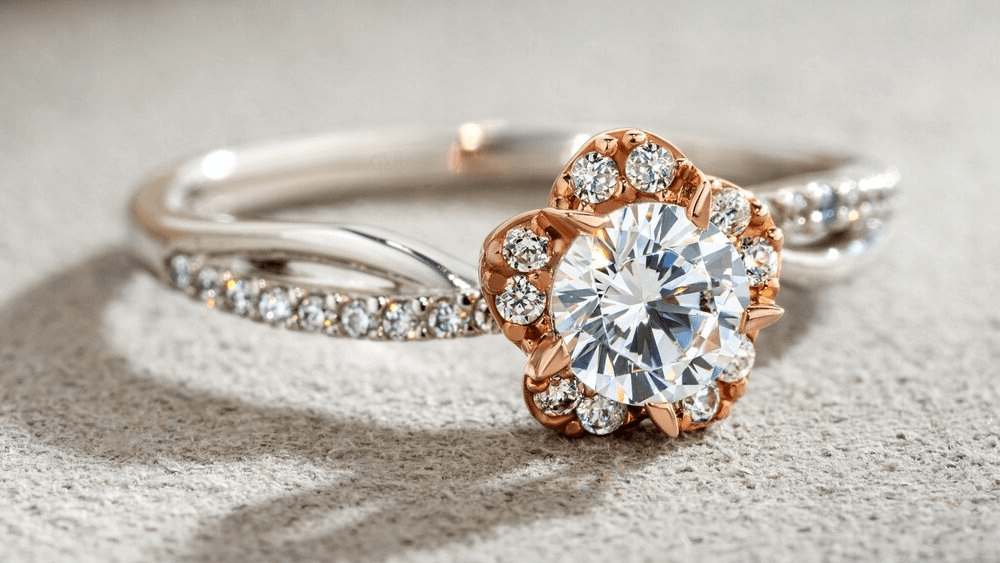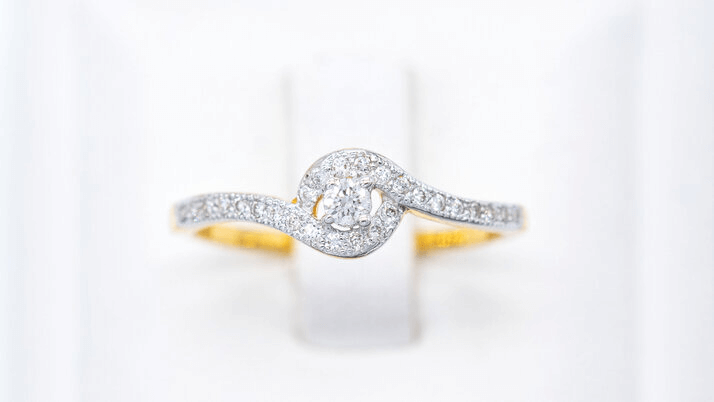Why Pear Shaped Diamond Rings Are Trending Now

By Gary A.

Edited by Olivia H.
Published Aug 9, 2024
Edited on Mar 31, 2025
Pear shaped diamond rings bring a unique elegance, combining timeless beauty with a teardrop design that sparkles with every glance—explore how this distinct shape makes your engagement ring unforgettable.

Navigate This Guide:
- 9 Quick Tips for Choosing the Right Pear Engagement Ring
- Introduction
- Embracing the Unique Beauty of Pear Diamonds
- Chapter 1: The History and Symbolism of Pear Shaped Diamonds
- Chapter 2: Understanding the Anatomy of a Pear Shaped Diamond
- Chapter 3: Selecting the Perfect Pear Shaped Engagement Ring
- Chapter 4: How to Wear and Style Your Pear Shaped Ring
- Our Expert Take
- 11 Frequently Asked Questions about Pear Shaped Engagement Rings
Before we dive deeper into the specifics, here are some practical tips to help guide your decision-making process:
9 Quick Tips for Choosing the Right Pear Engagement Ring
- Tip 1. Check the Symmetry:
- Why It’s Important: For pear-shaped diamonds, symmetry is vital to ensure the stone’s teardrop shape looks precise and appealing.
- What to Look For: Ensure that the pointed end aligns perfectly with the top of the rounded end, and check that the curves on both sides are even and symmetrical.
- Tip 2. Examine the Prongs and Setting:
- Why It’s Important: The prongs secure the diamond, and given the pear shape’s unique structure, this becomes critical.
- What to Look For: Ensure the point of the pear-shaped diamond is covered with a prong to protect it from chipping or breaking, as it’s a vulnerable point. V-tip prongs are often recommended for pear-shaped diamonds.
- Tip 3. Be Wary of the Bowtie Effect:
- Why It’s Important: Pear-shaped diamonds can exhibit a dark area in the middle, often referred to as the “bowtie effect.”
- What to Look For: Observe the diamond under various lighting conditions. A minimal bowtie effect is acceptable, but it shouldn’t dominate the stone’s appearance.
- Tip 4. Consider the Length-to-Width Ratio:
- Why It’s Important: The length-to-width ratio impacts the overall shape and aesthetic of the pear-shaped diamond.
- What to Look For: Identify your preferred proportion. A traditional pear shape usually has a length-to-width ratio between 1.45 and 1.75.
- Tip 5. Pay Attention to the Halo Setting (if chosen):
- Why It’s Important: A halo setting can enhance the size appearance of the central diamond.
- What to Look For: Ensure that the halo complements and doesn’t overshadow the pear shape. The halo should follow the stone’s unique shape closely to provide an aesthetic and protective boundary.
- Tip 6. Understand the Grading Report:
- Why It’s Important: A diamond grading report gives a comprehensive overview of the stone’s quality and characteristics.
- What to Look For: Ensure that your diamond comes with a grading report from a reputable lab (like GIA or AGS) and verify the characteristics (e.g., cut, carat, color, and clarity) as per your requirement and budget.
- Tip 7. Reflect on the Metal and Band:
- Why It’s Important: The metal chosen for the band will impact the overall look and durability of the ring.
- What to Look For: Consider how the metal color (e.g., yellow gold, white gold, rose gold, platinum) complements the diamond and the wearer’s skin tone. Additionally, check the sturdiness and durability of the chosen metal, especially if opting for a delicate band.
- Tip 8. Color and Clarity Considerations: Pear shaped diamonds can sometimes show color more noticeably, especially at the pointed tip. Consider opting for a higher color grade if the diamond is set in a white metal. Due to their brilliant cut, pear diamonds can hide inclusions well. You might be able to choose a diamond with a slightly lower clarity grade without impacting its visual appearance.
- Tip 9. Consider the Wedding Band Pairing: Given the unique shape of pear diamonds, finding a wedding band that aligns well can be challenging. Look for bands designed to accommodate the pear shape or consider a custom band for a seamless fit. Some prefer curved or notched bands that contour around the engagement ring, while others might opt for a simpler, straight band for contrast.
Now that you’ve got these practical tips, use Jeweler AI below to find the perfect engagement ring that suits your style and budget:
Introduction
Not many diamond shapes bring as much edge, as much personality, and as much sentiment to an engagement ring as the Pear. Yes, true, we give the Pear cut a relatively hard time for its vulnerability to the trend cycles – one year, Pears are at the top of any Pinterest Board or wish list and, the next, they’re pushed into obscurity once again. But, even so, one thing is true: if you make the bold decision to pick out a Pear engagement ring, you won’t regret it.
There are a few specifics you need to think about when investing in a pear shaped diamond engagement ring. Here’s everything you need to know.
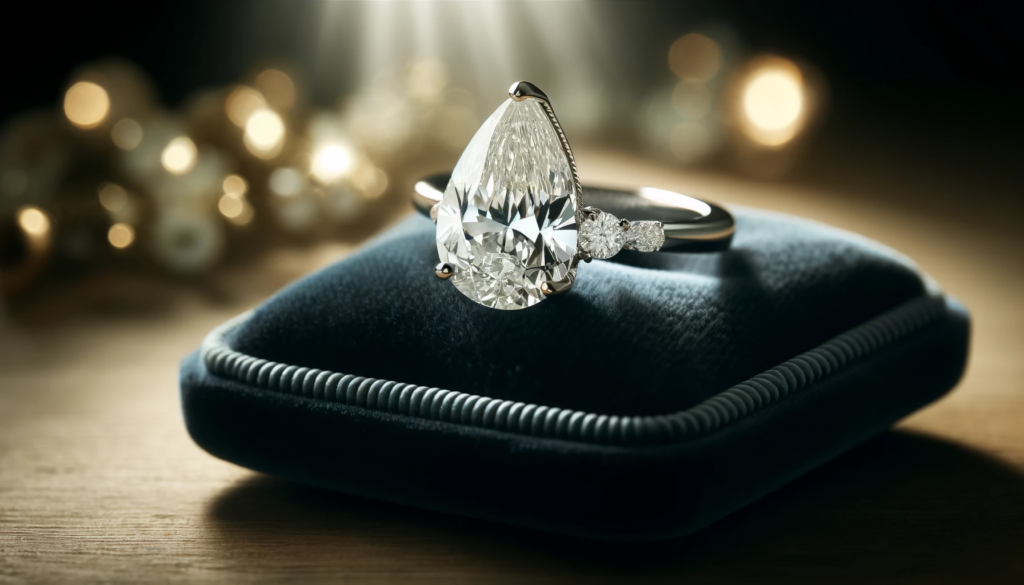
Embracing the Unique Beauty of Pear Diamonds
Pear diamonds are arguably one of the most distinctive diamond shapes. While a cushion can, from a distance, resemble a Round – a Princess could be confused with a Radiant at first glance – and an Asscher mistakenly called an Emerald, Pear cuts are as distinctive as they are true to their namesake.
As well as pears, this shape is often likened to teardrops – specifically (you’ll be glad to know) the happy tears shed at a proposal or wedding, rather than the other kind.
Pear shaped diamonds are asymmetrical, typically worn with the sharp tip pointed outwards, toward the fingernail, and cut according to a modified brilliant facet pattern. This means that, while they don’t sparkle as much as a Round Brilliant, they offer that same glittering display of fire and brilliance.
Chapter 1: The History and Symbolism of Pear Shaped Diamonds
Despite the fact that, compared with other diamond shapes, the Pear cut appears very modern, it’s actually one of the older options in jewelry stores today. Created in the 15th century by the inventor of the diamond polishing wheel (Lodewyk van Berquem of Bruges, if you can pronounce that), this shape was particularly popular during the 1700s, back when it was known as le pendeloque, meaning ‘the pendant’ or ‘the drop’.
From Royal Crowns to Modern Romance
The Pear has a particular affinity with royalty and nobility.
In 1885, the Rosse Tiara was created for the Countess of Rosse and was eventually passed down through generations of countesses. While the tiara features emeralds rather than diamonds, it’s a perfect example of the enduring beauty of the Pear cut, featuring nine stones spaced evenly across the tiara.
In 1937, renowned jeweler Cartier created a glistening kokoshnik tiara for Beatrice Forbes, Countess of Granard. The tiara featured many smaller diamonds along with several prominent pears, which brought a stunning balance of softness and strength to the design.
But it’s not just about the tiaras. Across the pond, the engagement ring presented to Princess Eugenie by now-husband Jack Brooksbank featured two pear shaped diamonds around the perimeter of a Padparadscha sapphire. While the rare stone is the star of the show, those Pear diamonds bring it to life with fire and brilliance.
Finally, as part of the British Royal Family’s extensive collection of crown jewels, the Cullinan III – which, when mined, weighed 3,106 carats – features a stunning Pear cut. The diamond has been featured in the Delhi Durbar Tiara, a brooch favored by Elizabeth II, and the Coronation Necklace.
Enduring Elegance: Elizabeth Taylor to Modern Stars
Switch lanes to Hollywood royalty, and you’ll find some stunning examples of Pear engagement rings from Katherine Heigl, Cardi B, Elizabeth Taylor, and Anna Kournikova – along with fashion icon Victoria Beckham.

Chapter 2: Understanding the Anatomy of a Pear Shaped Diamond
Pear shaped diamonds are a combination of a Round Brilliant and a Marquis, with an elongated and asymmetrical shape. These diamonds are relatively shallow, which makes them pretty effective at concealing color, and also offer a larger face-up appearance. In other words, the table and crown (the upper half of the diamond) take up more weight than the pavilion – so, even at the same carat size, Pears tend to look larger than Round Brilliants, and other deeper shades like Cushions.
Symmetry, Cut, and the Bowtie Effect
It’s vital that a Pear cut diamond has great symmetry since that sharp point will look cheap and low-quality if it’s not perfectly straight.
Poorer cut quality also leads to issues with bow ties – a black shadow that runs through the stone’s center and risks reducing sparkle and overall beauty. Read everything you need to know about bow ties here.
Understanding the Four Cs in Pear Shaped Diamonds
Carat weight is down to you and your budget, while color should be chosen from the Near Colorless range in order to get you the very best visual quality for the most attractive price. Clarity is more open-ended – Pears are relatively good at masking minor flaws thanks to their brilliant facet structure, but avoid going any lower on the scale than Si1 – or Si2, if your diamond is on the smaller side.
Keep in mind that even the most striking and carefully planned ring design will be let down by a poorly cut diamond. This is, of course, true of any shape, but the Pear is a particularly tricky shape to get right. It’s all too easy for a Pear to come out looking too long and narrow, too wide and stout, or so shallow or deep that the stone’s light performance is compromised. What’s more, the precise point of the pear can be cut into the rough off-center, meaning that, when viewed from above, the diamond will be noticeably wonky.
You’ll want to make sure that the diamond has a GIA grade of Excellent or Very Good for symmetry and polish, but also that it falls within the appropriate ranges for depth and table percentages, length-to-width ratio, girdle and culet (alongside the Four Cs, of course).
Also, the Pear Cut’s elongated shape means that it is vulnerable to the bow tie effect – a phenomenon that is, unfortunately, prevalent in Pear cuts, Marquise cuts, and Ovals.
Also, the Pear cut is prone to retaining color. This is a benefit for those picking out fancy color diamonds, but less convenient if you’re looking for a white diamond. If your diamond has a minor amount of color (say, it sits at I or J on the GIA scale) then a yellow or rose gold setting will be best for emphasizing the whiteness of the stone.
If you’re set on white gold or platinum, then you’ll want to invest in a higher color grade.
Chapter 3: Selecting the Perfect Pear Shaped Engagement Ring
So, you know the history, you know the challenges, and you know how to overcome them without spending top dollar. How do you put it all together?
The Art of Choosing the Right Setting
Pears are very versatile, but they do have weaker points – that sharp tip is more prone to sustaining damage than the curved base, so a setting that offers some protection is a great decision. That protection can be as simple as a prong placed at the very tip, or heavier duty like a bezel or halo.
Traditionally, a Pear is oriented in a north-to-south direction – in other words, that point either points toward the hand or toward the fingernail. It’s a lot less usual for a Pear to be oriented east to west, since that would create an asymmetrical design – but, these days, more people are interested in defying convention and creating something unexpected. You may also opt for an off-camber orientation; Megan Fox’s engagement ring from Machine Gun Kelly is a perfect example of the power of placing a Pear (or two) slightly askew.
Think about the prong and setting type, then spare some time to consider what embellishments (if any) you’ll want along the shank. Pavé, knife edge, channel set and twisted bands are all popular options.
The Impact of Metal Choices on Pear Shaped Designs
Pears are quite shallow, so they won’t swallow up too much of your metal’s color. This is great news if you know you’re going to go for a yellow or rose gold but worry about the reflection of that metal through the center of the diamond.
Besides, a lot of people love the way it looks!
Platinum and white gold both create a very crisp, modern, icy appearance when paired with a pear cut diamond. Here, a great color grade from the Near Colorless range is essential, since the stark whiteness of the metal will accentuate any slight trace of yellow in your diamond.

Solitaire Settings: Timeless Elegance
The Pear shape is striking enough to stand out on its own, without the need for any extra embellishments, and embracing the most classic design of all means that your ring will never be the subject of changing fashions or trends. More so than the Round or Emerald, the Pear cut can drift in and out of popularity, but a design as simple and timeless as the solitaire is pretty much immune.
More recently, a number of designs have popped up featuring the Pear cut set horizontally across the finger, rather than vertically. While bold and indisputably ‘new’, the design banks on you being okay with a ring that is defined by asymmetry. It’s a great way to reinvent the solitaire but, for many people – and, in particular, people who admire the shape of the Pear without worrying about passing trends – the Pear solitaire may not need reinventing.

Split Shank Settings for Pear Cuts: Modern Sophistication
Like the solitaire, the diamond itself can command all the attention in a split shank setting. As an elongated shape, the double shank is highly flattering and appears to branch out towards the tip and base of the diamond in a way that is elegant, yet unobtrusive.
Pear Cut Pavé Engagement Rings
Feminine, sparkly, and highly romantic, the Pear’s brilliance and fire can be echoed perfectly within a pavé shank. If you want to go even further, consider a halo – but for the perfect combination of elegance and extravagance, a pavé band lends the ideal ‘backdrop’ to your diamond.
Bezel and Tension Settings: Contemporary Choices
A bezel is a solid ribbon of metal that wraps around the full edge of the diamond. It’s a little less common in engagement rings, predominantly because it blocks considerably more of the diamond from the light, limiting its sparkle. Of course, bezel-set diamonds still produce fire and brilliance, but compared with prong-set diamonds, there is a noticeable difference.
The bezel is, however, beautifully modern and minimalistic. Against yellow gold, the luminescent quality of the diamond is brought into sharp relief, while the design itself creates a comfortable, practical, and streamlined ring that emphasizes the shape of the Pear.
Alternatively, a half bezel ring will echo the asymmetricity of your Pear cut and leave a little more of the stone exposed to the light. It’s a great middle ground if you love the streamlined, contemporary look of the bezel, but don’t want to disguise too much of the stone’s outer edge.
Alternatively, the tension setting is one of the most fascinating to look at and relies on the pressure between the two open ends of the shank to hold the diamond in place, rather than any prongs. It’s a lot more secure than it sounds, and the results are breathtaking. This unique approach to design echoes the innovation seen in the Toi et Moi Ring, where two stones symbolize the union of two souls.
A tension setting makes it easy for you to use the Pear cut’s asymmetry to your advantage. The diamond can be set between the two ends of the shank at an angle, rather than the usual vertical arrangement. It’s a small change, but very powerful, and looks particularly attractive in white gold or silver.
Using the Pear Cut as an Accent
If you love the Pear but prefer the versatility of a different diamond, then this cut offers the perfect accent to a center stone. Placed horizontally, they can resemble leaves or petals growing on either side of the center stone. Paired with an Emerald cut, they bring sparkle to the design – paired with a Round Brilliant, however, they create a wonderfully floral vibe (particularly on a twisted shank, or against some delicate filigree).
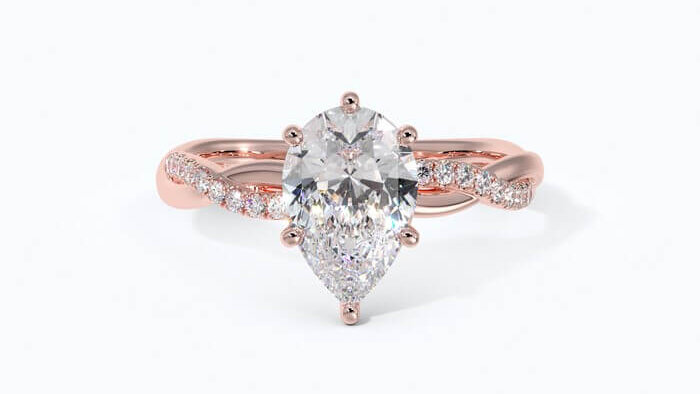
Chapter 4: How to Wear and Style Your Pear Shaped Ring
Pulling off a pear shaped engagement ring is all about confidence, and knowing that the ring on your finger is the epitome of exquisite design, historic influence, and royal favor.
Consider opting for a wedding band specifically designed to accommodate the Pear’s unusual shape. A chevron is perfect for this, or a curve – it just depends on which side of the Pear you’re planning on wearing the wedding band. Most people opt to wear the wedding band closer to the base of the finger, and the engagement ring on top – but you do you!
Ring Orientation and Symbolism
Most people prefer the look of a Pear that points toward the fingernail, not the knuckle.
Remember that there are no hard-and-fast rules about this, and your ring’s intended wearer may prefer to go against the grain when it comes to styling her ring. And, besides, if you pick something like a tension ring setting, the diamond is probably going to naturally point in a totally different direction.
Also, consider the fact that off-set diamonds are also becoming increasingly popular. Ariana Grande’s headline-making engagement ring featured an offset Oval, for instance, while Megan Fox’s engagement ring features two off-set Pear cuts – one diamond, the other emerald.
But, if your design has the Pear aligned vertically so that it runs with the shape of the finger, it’ll be up to the wearer which way it goes on. Then again, consider this…
Matching with Wedding Bands
It’s best to get your wedding band specially designed to accommodate the shape of the pear, or you may end up with an uncomfortable or unsightly gap. This is very easy, particularly if you return to the same jeweler who designed the engagement ring.
Since most people choose to wear their engagement ring with the tip pointing toward their finger (and their wedding band beneath the engagement ring), the band only needs to accommodate the rounded curve of the Pear’s base, which is a lot like accommodating any other round diamond.
For those with halos, it’s always best to have the wedding band designed according to their specific requirements. Going for a typical, round wedding band could easily mean you wind up with something with too wide a curve (or too shallow, too deep, or too narrow a curve) to fit the unique shape of your halo.
You may want to purchase your engagement ring as part of a bridal set, so that you don’t need to worry about the wedding band further down the line.
Our Expert Take
A Pear engagement ring will always be one of our favorite choices. Yes, the Pear is more divisive than the round brilliant or the oval, but that just gives it even more character and appeal to those of us who appreciate its unique silhouette, its asymmetry, and its divine sparkle.
Our Jeweler AI can help you find the perfect pear engagement ring.
11 Frequently Asked Questions about Pear Shaped Engagement Rings
- Q: What makes a pear shaped engagement ring unique?
- A: A pear shaped engagement ring features a diamond that combines the round brilliant and marquise cuts, creating a teardrop shape. This unique silhouette is elegant, elongates the finger, and offers a distinctive, yet timeless appeal.
- Q: How should a pear shaped engagement ring be worn?
- A: Typically, a pear shaped engagement ring is worn with the point of the diamond facing towards the fingernail, giving an elongated look to the finger. However, it’s a personal choice and some may prefer the point facing the wrist.
- Q: What is the ideal length-to-width ratio for a pear shaped diamond?
- A: The ideal length-to-width ratio for a pear shaped diamond varies depending on personal preference, but it generally falls between 1.45 and 1.75. This range maintains the classic pear shape’s balance and elegance.
- Q: Can a pear shaped ring fit any hand or finger type?
- A: Yes, pear shaped rings can suit any hand or finger type. The elongated shape of the pear diamond tends to flatter and elongate the appearance of the fingers, making it a versatile choice.
- Q: What should I look for in the quality of a pear shaped diamond?
- A: Focus on symmetry, as it’s crucial for the beauty of a pear shaped diamond. Also, pay attention to the diamond’s cut, color, clarity, and the presence of a bowtie effect, which should be minimal or absent.
- Q: Are pear shaped diamonds more expensive than other shapes?
- A: The price of pear shaped diamonds can vary widely depending on the 4Cs (cut, color, clarity, and carat weight). They are often less expensive than round brilliants but can be pricier than some other fancy shapes due to their cutting complexity.
- Q: How do I protect the pointed end of a pear shaped diamond?
- A: Ensure the ring’s setting has a prong at the pointed end of the diamond, often a V-tip prong, to protect it from chipping or snagging. This is a crucial aspect of the setting for pear shaped stones.
- Q: How do I choose the right setting for a pear-shaped diamond?
- A: Look for settings that provide stability and protect the pointed tip of the diamond. Bezel and halo settings are popular choices because they offer protection while enhancing the diamond’s appearance.
- Q: Can I pair a pear-shaped engagement ring with a straight wedding band?
- A: Yes, but be mindful of potential gaps. Some prefer custom curved bands that fit snugly around the pear-shaped engagement ring for a seamless look.
- Q: What is the best metal for a pear-shaped diamond ring?
- A: Platinum and white gold are popular for their durability and ability to enhance the diamond’s brilliance. Yellow and rose gold are great for a warmer, vintage aesthetic.
- Q: How can I protect the tip of my pear-shaped diamond?
- A: Choose a setting with a V-tip prong at the point of the diamond. This extra protection helps prevent chipping or damage to the tip.
Find your perfect pear with Jeweler AI – where elegance meets precision.
FOLLOW-UP GUIDE SERIES





